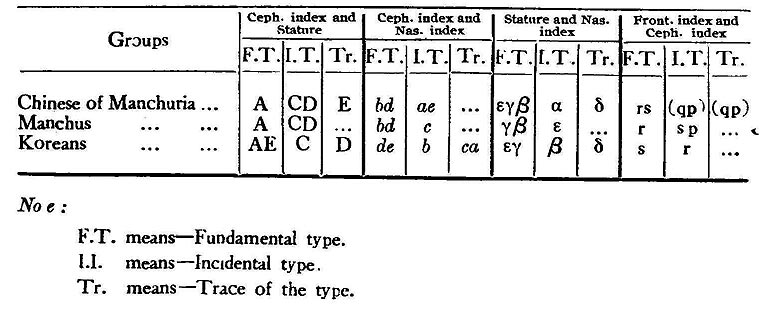48. Comparison of the Results of the Analysis
In chapter IV, I have concluded that the Chinese of Manchuria show such distinctive characteristics that from some standpoints they are closer to the Manchus and Koreans than to the Chinese of China Proper. Also in chapter III, I have concluded that the difference between MM of this group and MM of the Koreans (in relative measurements) is less than those between the Chinese of Manchuria and Chinese of China Proper. Thus this group was influenced by their neighbours, as I shall illustrate in the following Table:

At a glance it may be seen that the Chinese of Manchuria and the Manchus, also the Koreans, are very close according to their components. In all the cases they have the common fundamental types. The difference between the Koreans and the Chinese of Manchuria consists in the variation of the intensivity of the types. In one case, only namely the case of the Frontal index and Cephalic index the Chinese of Manchuria have two incidental types, — or perhaps the traces of «them, — which are not observed among the Koreans. It seems to me that the Manohus are njt so amalgamated as other groups under discussion, but they have always the same components as the other two groups. From some points of view they are cbser to the Koreans, from other points of view they are closer to the Chinese of Manchuria. Therefore the coefficient of differences between the Chinese of Manchuria and Koreans (coef. Δ=4.780) and on the other hand the coefficient of differences between the Manchus and Chinese of Manchuria Ccoef. Δ=5.249) are lower than the coefficients of differences between the Koreans and Manchus (coef. Δ=6.498). This phenomenon may be explained by the presence of the types characteristic of these groups and quite opposite to each other, as are the type B and the types Γ and Δ. At the same time some common types in this table only change their places — among the Manchus they are fundamental and among the Koreans incidental or contrary. From this Table it may be seen also that the influence of. the Manchurian environment over the Chinese immigrants or colonists is very effective and these Chinese have lost some anthropological characteristics [100].
The differences of MM of the Chinese groups of China Proper are not so high, therefore the coefficient of differences also are very insignificant, but the real difference between these groups is more significant. These groups are composed generally of the different anthropological types with preponderance of some of them. The fact that these types by their characteristics are opposite and the groups besides include some common types confuse the real meaning of MM. The following Table can illustrate the above proposition:

The degree of the amalgamation with their neighbours is, of course, different and depends not only on the intensity of the influence through the direct contact of these groups but probably also on the ancient amalgamation of the fundamental types now composing these groups. It seems to me that the group of Chihli from some points of view is closer to the Koreans than the group of Shantung. In the field of correlation this might be observed many times. The coefficients of differences seem to prove this proposition. In fact the coefficient of difference between the Chinese of Chihli and Koreans (coef. Δ =6.451; coef. of relative measurements Δ =4.724) is lower than that between the Chinese of Shantung and Koreans (coef. Δ =6.709; coef. of relative measurements Δ =6.121).
Thus the comparison of the results of the analysis by the methods of interserial differences and method of correlation and also the descriptive characteristics show the coincidence of deductions.
In my anthropological analysis I suppose that the individuals which compose a group of only one type show the variations of their characteristics. The coefficient of variation and the standard deviation show the degree of the dispersion and closeness of the main mass of the group with the average type, characterized by MM. If this is so, ithen the amalgamation of two and more types form a majority of the amalgamated individuals and a minority of the pure «race», which are usually located on the periphery of the fields of correlation. The characteristics of these types in ciphers may be, of course, defined with a very relative exactness.
100. Facts of this kind are known already. The influence of the anthropological types characteristic of the local populations over the Jews was so effective that some groups of the Jews changed their anthropological feature. (The opinion of Mr. L. J. Sternberg).